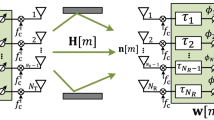Abstract
Utilizing mmWave massive MIMO frontends for base station to mobile communication promises unprecedented throughput gains in cellular networks. Power efficiency is a significant bottleneck in scaling to the large array sizes required for closing the link at high frequencies, particularly in the battery-powered handset. Conventional phased array architectures at 100+ GHz require close to 100 mW of power per receive antenna, making them ill-suited for scaling to massive arrays. In this paper, we propose drastically simplified receiver frontend designs that are predicted to slash this per-channel wattage by an order of magnitude or more at 140 GHz. These power savings come at the cost of imperfect beamforming and under-utilization of the array elements and die area. We quantify these tradeoffs for our baseline on-off architecture, as well as 1-bit and 2-bit phase switched arrays. In the lowest resolution setting, on-off beamforming, we show that beamforming efficiency of 70% is achieved with 40% utilization of the aperture. This tradeoff improves significantly with the adoption of even the most coarse (1 or 2 bit) phase control, motivating us to pursue power-optimized designs for low-precision mmWave phase shifters.











Similar content being viewed by others
Notes
These numbers do not include the power consumption of the LO that drives the IF mixers, as the values reported in these references were lumped up with that of the LO multiplier, which is a shared component. With the optimistic assumption of only a few mW consumption by each channel’s LO driver, the state of the art design can be assumed to burn 80+ mW per channel (excluding consumption of shared components).
Finding the best possible phasor selection can be done with \(\mathcal {O}(N)\) computational complexity, and only needs to be repeated on the time scale of channel coherence.
References
Rodwell, M. J. (2019). 100-340GHz Spatially Multiplexed Communications: IC, Transceiver, and Link Design. In 2019 IEEE 20th International Workshop on Signal Processing Advances in Wireless Communications (SPAWC) (pp. 1-5)
Rodwell, M. J. W., Farid, A. A., Ahmed, A. S. H., Seo, M., Soylu, U., Alizadeh, A., & Hosseinzadeh, N. (2021). 100-300GHz Wireless: ICs, Arrays, and Systems. In 2021 IEEE BiCMOS and Compound Semiconductor Integrated Circuits and Technology Symposium (BCICTS) (pp. 1-4)
Puglielli, A., Townley, A., LaCaille, G., Milovanović, V., Lu, P., Trotskovsky, K., et al. (2015). Design of energy- and cost- efficient massive MIMO arrays. Proceedings of the IEEE, 104(3), 586–606.
Skrimponis, P., Dutta, S., Mezzavilla, M., Rangan, S., Mirfarshbafan, S. H., Studer, Buckwalter, J., & Rodwell, M. (2020). Power consumption analysis for mobile mmWave and sub-THz receivers. In 2020 2nd 6G Wireless Summit (6G SUMMIT) (pp. 1-5). IEEE
Skrimponis, P., Hosseinzadeh, N., Khalili, A., Erkip, E., Rodwell, M. J., Buckwalter, J. F., & Rangan, S. (2020). Towards energy efficient mobile wireless receivers above 100 GHz. IEEE Access 9 20704-20716
Li, S., & Rebeiz, G. M. (2020). A 134-149 GHz IF beamforming phased-array receiver channel with 6.4-7.5 dB NF using CMOS 45nm RFSOI. In 2020 IEEE Radio Frequency Integrated Circuits Symposium (RFIC) (pp. 103-106). IEEE
Nicolson, S. T., Tomkins, A., Tang, K. W., Cathelin, A., Belot, D., & Voinigescu, S. P. (2008). A 1.2 V, 140GHz receiver with on-die antenna in 65nm CMOS. In 2008 IEEE Radio Frequency Integrated Circuits Symposium (pp. 229-232). IEEE
Abbas, W. B., Gomez-Cuba, F., & Zorzi, M. (2017). Millimeter wave receiver efficiency: A comprehensive comparison of beamforming schemes with low resolution ADCs. IEEE Transactions on Wireless Communications, 16(12), 8131–8146.
Mollén, C., Choi, J., Larsson, E. G., & Heath, R. W. (2017). Achievable uplink rates for massive MIMO with coarse quantization. 2017 IEEE International Conference on Acoustics (pp. 6488–6492). IEEE: Speech and Signal Processing (ICASSP).
Jacobsson, S., Durisi, G., Coldrey, M., Gustavsson, U., & Studer, C. (2017). Throughput analysis of massive MIMO uplink with low-resolution ADCs. IEEE Transactions on Wireless Communications, 16(6), 4038–4051.
Bakr, O., Johnson, M., Park, J., Adabi, E., Jones, K., & Niknejad, A. (2010). A scalable-low cost architecture for high gain beamforming antennas. In 2010 IEEE International Symposium on Phased Array Systems and Technology (pp. 806-813). IEEE.
Heller, T., Cohen, E., & Socher, E. (2016). A 102–129-GHz 39-dB gain 8.4-dB noise figure I/Q receiver frontend in 28-nm CMOS. IEEE Transactions on Microwave Theory and Techniques, 64(5), 1535-1543
Hajimiri, A., Hashemi, H., Natarajan, A., Guan, X., & Komijani, A. (2005). Integrated phased array systems in silicon. Proceedings of the IEEE, 93(9), 1637–1655.
Babakhani, A., Guan, X., Komijani, A., Natarajan, A., & Hajimiri, A. (2006). A 77-GHz phased-array transceiver with on-chip antennas in silicon: Receiver and antennas. IEEE Journal of Solid-State Circuits, 41(12), 2795–2806.
Cohen, E., Ruberto, M., Cohen, M., Degani, O., Ravid, S., & Ritter, D. (2013). A CMOS bidirectional 32-element phased-array transceiver at 60 GHz with LTCC antenna. IEEE Transactions on Microwave Theory and Techniques, 61(3), 1359–1375.
Mamandipoor, B., Ramasamy, D., & Madhow, U. (2015). Frequency estimation for a mixture of sinusoids: A near-optimal sequential approach. In 2015 IEEE Global Conference on Signal and Information Processing (GlobalSIP) (pp. 205-209). IEEE
Rasekh, M. E., Marzi, Z., Zhu, Y., Madhow, U., & Zheng, H. (2017). Noncoherent mmWave path tracking. In Proceedings of the 18th International Workshop on Mobile Computing Systems and Applications (pp. 13-18)
Rasekh, M. E., & Madhow, U. (2018). Noncoherent compressive channel estimation for mm-wave massive MIMO. In 2018 52nd Asilomar Conference on Signals, Systems, and Computers (pp. 889-894)
Rasekh, M., Puranik, B., Madhow, U., Rodwell, M. (2022). In-the-field calibration of all-digital mimo arrays. In: 2022 IEEE Wireless Communications and Networking Conference (WCNC), IEEE
Acknowledgements
This work was supported in part by ComSenTer, one of six centers in JUMP, a Semiconductor Research Corporation (SRC) program sponsored by DARPA.
Author information
Authors and Affiliations
Corresponding author
Additional information
Publisher's Note
Springer Nature remains neutral with regard to jurisdictional claims in published maps and institutional affiliations.
Rights and permissions
About this article
Cite this article
Rasekh, M.E., Hosseinzadeh, N., Madhow, U. et al. Low-Resolution Architectures for Power-Efficient Scaling of mmWave Phased Array Receivers. J Sign Process Syst 94, 1005–1014 (2022). https://doi.org/10.1007/s11265-022-01769-0
Received:
Revised:
Accepted:
Published:
Issue Date:
DOI: https://doi.org/10.1007/s11265-022-01769-0




